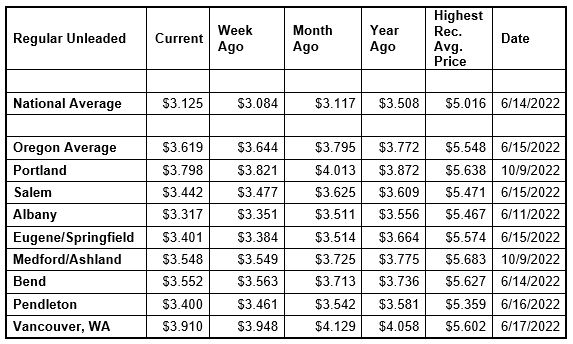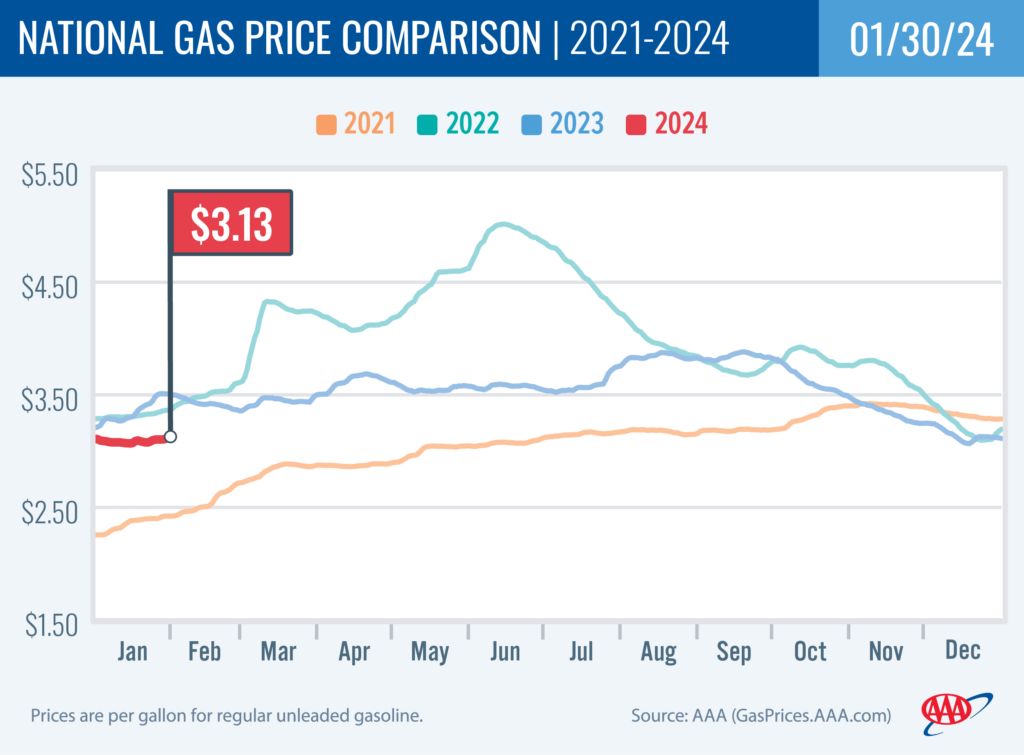PORTLAND, Ore., – Most states are seeing pump prices rise this week, but Oregon continues to see prices inch down for now. Gas prices are rebounding after winter weather events across the country, and crude oil prices are on the rise in response to positive economic news and more attacks in the Middle East. For the week, the national average for regular rises four cents to $3.13 a gallon. The Oregon average slips two cents to $3.62.

“Pump prices had been moving up and down slightly for the past few weeks but now we’re seeing larger increases in some states. If crude oil prices continue to rise, we will see more widespread increases in pump prices,” says Marie Dodds, public affairs director for AAA Oregon/Idaho. “This is the time of year we tend to see gas prices bottom out before starting their seasonal climb, and that holds true as we wrap up the first month of 2024.”
The national and Oregon averages are at their lowest prices since July 2021. All counties in Oregon except Curry ($4.25) have averages below $4 a gallon.
Gas prices normally rise in the first and/or second quarters of the year. The factors include refinery maintenance season, the normal seasonal growth in demand, and the switch from winter-blend fuel to summer-blend, which is more expensive to produce. Summer-blend gas helps reduce emissions from gasoline during the warm summer months. More info on summer- and winter-blend gasoline can be found at the EPA website.
Crude oil prices are at their highest prices since November. They continue to be volatile on concerns surrounding mounting geopolitical tensions in the Middle East after this week’s deadly drone attack on U.S. troops in the area as well as ongoing attacks on commercial vessels in the Red Sea. The conflict between Israel and Hamas has led to additional violence in the West Bank, Lebanon, Syria and Iraq. While Israel and the Palestinian territory are not oil producers, there’ve been concerns that the conflict could spread in the Middle East, which could potentially impact crude production in other oil-producing nations in the region.
Also today, the International Monetary Fund (IMF) raised its forecast for the global economy on unexpectedly strong economic growth in the U.S. and stimulus in China. In general, strong economic growth leads to higher crude oil prices, as nations with expanding economies consume more crude oil than those with shrinking economies.
Crude oil is trading around $78 today compared to $74 a week ago and $78 a year ago. In 2023, West Texas Intermediate ranged between $63 and $95 per barrel. Crude reached recent highs of $123.70 on March 8, 2022, shortly after the Russian invasion of Ukraine, and $122.11 per barrel on June 8, 2022. The all-time high for WTI crude oil is $147.27 in July 2008.
Crude oil is the main ingredient in gasoline and diesel, so pump prices are impacted by crude prices on the global markets. On average, about 56% of what we pay for in a gallon of gasoline is for the price of crude oil, 8% is refining, 19% distribution and marketing, and 16% are taxes, according to the U.S. Energy Information Administration.
Demand for gas in the U.S. decreased from 8.27 to 7.89 million b/d for the week ending January 19, according to the U.S. Energy Information Administration (EIA). This compares to 8.14 million b/d at the same time last year. Meanwhile, total domestic gasoline stocks increased by 4.9 million bbl to 253 million bbl.
Due to fluctuating oil prices, lower gas demand, and rising stocks, pump price increases have been limited. If oil prices continue to see upward pressure, drivers could see pump prices increase steadily in the weeks ahead.
Quick stats
Oregon is one of 13 states with lower prices now than a week ago. Delaware (+16 cents) has the largest week-over-week gain. Ohio (-12 cents) has the biggest weekly drop. Seven states are seeing prices rise by a dime or more.
Hawaii ($4.68) has the most expensive gas in the nation for the third week in a row. California ($4.52) is second. These are the only two states with averages at or above $4, same as a week ago. This week 20 states and the District of Columbia have averages in the $3-range. Twenty-eight states have averages in the $2 range this week.
The cheapest gas in the nation is in Wyoming ($2.66) and Oklahoma ($2.70). No state has had an average below $2 a gallon since January 7, 2021, when Mississippi and Texas were below that threshold.
The difference between the most expensive and least expensive states is $2.02 this week, compared to $2.10 a week ago.
Oregon is one of 28 states with lower prices now than a month ago. The national average is one cent more and the Oregon average is 18 cents less than a month ago. This is the fifth-largest monthly drop in the nation. Idaho (-29 cents) has the largest monthly drop. Texas (+15 cents) has the largest month-over-month increase.
All 50 states and the District of Columbia have lower prices now than a year ago. The national average is 38 cents less and the Oregon average is 15 cents less than a year ago. Colorado ($1.11) has the largest yearly decrease.
West Coast
The West Coast region continues to have the most expensive pump prices in the nation with six of the seven states in the top 10. It’s typical for the West Coast to have six or seven states in the top 10 as this region tends to consistently have fairly tight supplies, consuming about as much gasoline as is produced. In addition, this region is located relatively far from parts of the country where oil drilling, production and refining occurs, so transportation costs are higher. And environmental programs in this region add to the cost of production, storage and distribution.
| Rank | Region | Price on 1/30/24 |
| 1 | Hawaii | $4.68 |
| 2 | California | $4.52 |
| 3 | Washington | $3.95 |
| 4 | Nevada | $3.81 |
| 5 | Oregon | $3.62 |
| 6 | Alaska | $3.48 |
| 7 | Pennsylvania | $3.35 |
| 8 | District of Columbia | $3.32 |
| 9 | New York | $3.27 |
| 10 | Illinois | $3.22 |
As mentioned above, Hawaii has the most expensive gas in the country for the third week in a row. California, Washington, Nevada, Oregon, and Alaska round out the top six. Arizona is 17th. Oregon is fifth most expensive for the 15th week in a row.
Four of the seven states in the West Coast region are seeing week-over-week increases: Arizona (+6 cents), Nevada (+4 cents), California (+2 cents), and Hawaii (+1 cent). Alaska (-4 cents), Washington (-3 cents), and Oregon (-3 cents) have week-over-week declines.
The refinery utilization rate on the West Coast fell from 85.5% to 81.5% for the week ending January 19. This rate has ranged between about 73% to 96% in the last year. The latest national refinery utilization rate dropped from 92.6% to 85.5%.
According to EIA’s latest weekly report, total gas stocks in the region rose from 30.32 million bbl. to 31.92 million bbl.
A lower refinery utilization rate can put upward pressure on pump prices, while an increase in gasoline stocks can put downward pressure on pump prices.
Oil market dynamics
Crude oil prices jumped this week after the International Monetary Fund raised its global growth forecast for 2024 and in response to a deadly drone attack on U.S. forces in the Middle East. Oil prices also rose last week after the EIA reported that total domestic commercial crude stocks decreased significantly by 9.2 million bbl to 420.7 million bbl. The drop in total stocks signals that tight supply could increase prices if demand grows.
At the close of Friday’s formal trading session, WTI jumped $2.27 to settle at $77.36. At the close of Monday’s formal trading session, WTI fell $1.23 to settle at $76.78. Today crude is trading around $78 compared to $74 a week ago. Crude prices are about $3 lower than a year ago.
Drivers can find current gas prices along their route with the free AAA Mobile app for iPhone, iPad and Android. The app can also be used to map a route, find discounts, book a hotel and access AAA roadside assistance. Learn more at AAA.com/mobile.

Diesel
For the week, the national average ticks up half a cent to $3.92 a gallon. The record high is $5.816 set on June 19, 2022. The Oregon average falls four cents to $4.18. The record high is $6.47 set on July 3, 2022. A year ago the national average for diesel was $4.68 and the Oregon average was $4.78.
Find current fuel prices at GasPrices.AAA.com.
AAA news releases, high resolution images, broadcast-quality video, fact sheets and podcasts are available on the AAA NewsRoom at NewsRoom.AAA.com.
Find local news releases at https://oregon.aaa.com/community/media/media-contacts.html
Fuel prices are updated daily at AAA’s Daily Fuel Gauge at AAA Gas Prices. For more info go www.AAA.com. AAA Oregon/Idaho provides more than 890,000 members with travel, insurance, financial and automotive-related services, and is an affiliate of AAA National, serving more than 64 million motorists in North America.

